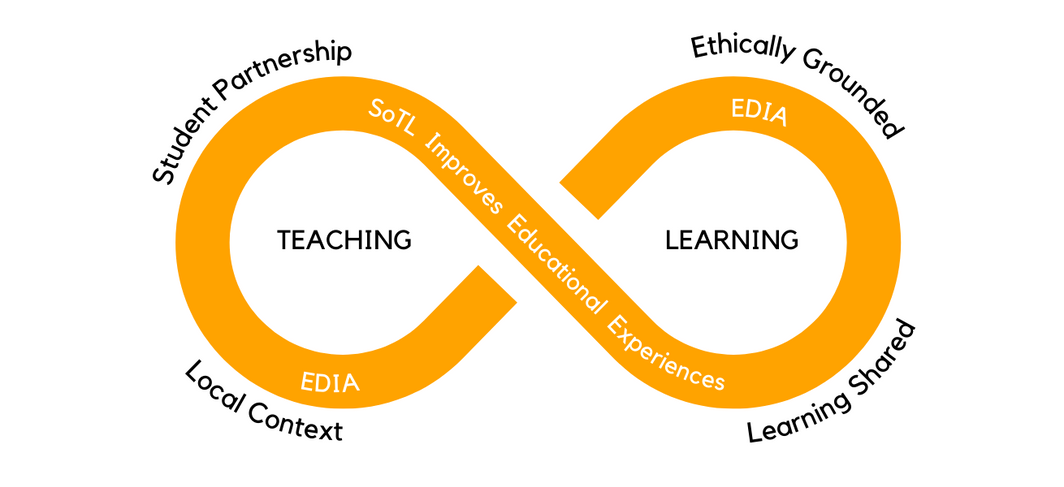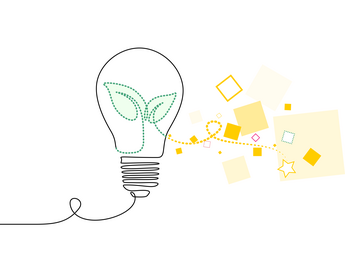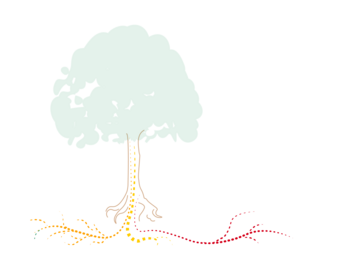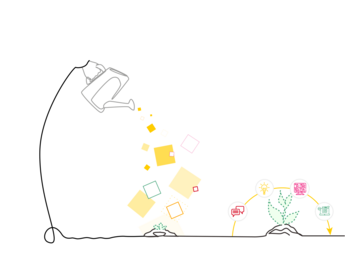The Scholarship of Teaching and Learning (SoTL) is about connecting teaching, learning, and research in our own courses and across academic disciplines. SoTL is exciting because it is transdisciplinary and collaborative. It connects and brings together undergraduate students, graduate students, postdoctoral scholars, staff, and faculty from all parts of campus.
In this lesson, we will introduce how SoTL improves educational experiences. We will also share examples and resources for learning about SoTL. By the end of this module, you will have started your journey in SoTL by connecting with a community of scholars.
SoTL aims to positively impact educational experiences
The Scholarship of Teaching and Learning (SoTL) includes a range of approaches that seek to support and advance high-quality educational experiences.
SoTL activities can include designing courses, facilitating classroom activities, experimenting with new pedagogical ideas, providing guidance to and partnering with students, writing student learning outcomes and evaluating programs. Any scholarship, research, or inquiry activities with a focus on supporting student learning experiences can be considered SoTL (Hutchings, Huber, & Ciccone, 2011).
SoTL practices support high-quality and impactful educational experiences (see Bernstein, 2013) in the following ways:
- Cultivating a mindset of curiosity and creativity in teaching and learning among students, faculty, staff, and educational leaders
- Bringing together individuals from across campus and the wider community in collaborative teaching and learning activities
- Incorporating and developing diverse scholarship methodologies and ways of knowing
- Applying and sharing learnings across campus and beyond
- Bridging disciplines and fields to offer multiple ways to approach the educational phenomenon while yielding richer and more complex understandings
SoTL work in campus communities has an impact on classes, communities of practice, professional development, curriculum review, experiential learning settings and community engagement. SoTL practitioners share their learnings in all of these settings, as well as at seminars and conferences, through publications, essays, and open-education resources.
Lesson Checklist
- Describe the goals, practices, and educational impacts of engaging in SoTL
- Connect with resources and communities that support SoTL
Principles of SoTL
SoTL is transdisciplinary, with scholars bringing perspectives and research methods from all disciplines. With an overall goal of improving educational experiences and supporting equity, diversity, inclusion and accessibility in higher education, the principles of SoTL (Felten, 2013) include:
- A goal of improving student learning and educational experiences
- Involving students as partners in inquiry and learning
- Questions are grounded in local context and current knowledge
- Conducted using sound and ethical methods
- Learning is shared with others

Benefits of SoTL
SoTL occurs when teaching and learning, inquiry and student partnership intersect. This synergy creates opportunities for new discoveries and approaches to student learning experiences. A collaborative approach among faculty, staff, students and administrators fosters a culture of continuous learning. This enriches educational and research experiences, and contributes to personal and professional growth.
Connecting to SoTL Learning Communities
There are many ways to connect with the SoTL community and begin your journey in SoTL. SoTL is an inclusive community where you can choose a level of engagement that works best for you at different times. There is a wide continuum of opportunities to join the SoTL community, including:
- Learning about others' work
- Reflecting on your teaching approach
- Sharing your knowledge through podcasts and blogs
- Applying for funding (e.g., University of Calgary Teaching and Learning Grant for members of the UCalgary community).
Many times a great first step is an informal conversation. See the Building Your SoTL Community activity to reflect on and build your a group of critical friends in SoTL.
Activity
Conferences and Events
- Conference on Postsecondary Learning and Teaching>>
- Non-UCalgary practitioners are encouraged to attend.
- Go to a Conference>>
Resources and Publications
Societies and Professional Groups
Additional Resources
This ISSOTL Online 2013 strand introduces attendees to SoTL and ISSOTL. It focuses on points of debate in the field's history, facilitates discussion of seminal readings, and situates the 2013 conference theme in relation to the field's development.
Gary Poole is a professor emeritus in the School of Population and Public Health and a senior scholar in the Centre for Health Education Scholarship at the University of British Columbia (Canada). In this playlist, Poole shares his knowledge on the subject of SoTL
References
Blaher, B., & Arkoudis, S. (Eds.). (2023). The educational turn: Rethinking higher education. Springer. https://doi.org/10.1007/978-981-19-8951-3_3
Bernstein, D. (2013). How SoTL-active faculty members can be cosmopolitan assets to an institution. Teaching and Learning Inquiry, 1(1), 35–40. https://doi.org/10.20343/teachlearninqu.1.1.35
Felten, P. (2013). Principles of good practice in SoTL. Teaching & Learning Inquiry, 1(1), 121–125. https://doi.org/10.20343/teachlearninqu.1.1.121
Felten, P., Bragg, J., Bumbry, M., Hill, J., Hornsby, K., Pratt, M., & Weller, S. (2013). A call for expanding inclusive student engagement in SoTL. Teaching & Learning Inquiry: The ISSOTL Journal, 1(2), 63–74. https://doi.org/10.20343/teachlearninqu.1.2.63
Harrington, K., Flint, A., & Healey, M. (2014). Engagement through partnership: Students as partners in learning and teaching in higher education. Higher Education Academy. https://s3.eu-west-2.amazonaws.com/assets.creode.advancehe-document-manager/documents/hea/private/resources/engagement_through_partnership_1568036621.pdf
Hutchings, P., Huber, M. T., & Ciccone, A. (2011). The scholarship of teaching and learning reconsidered: Institutional integration and impact (Vol. 21). John Wiley & Sons.
Waller, K. L., & Prosser, M. (2023). The rapidly changing teaching and research landscape: The future of SoTL and the teaching-research nexus. In K. Coleman & D. Uzhegova (Eds.), The educational turn: Rethinking higher education (pp. 27–41). Springer.




